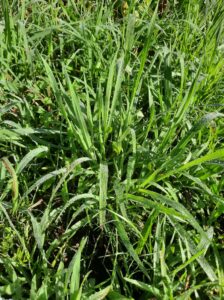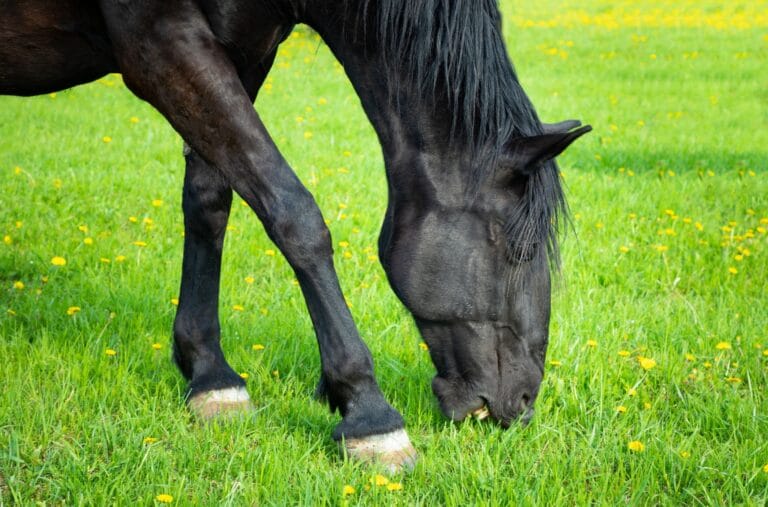One major management issue for horse owners is high oxalate grasses and the huge effect they can have on their horses. Oxalates bind to calcium and other minerals in the body and this locks the minerals up in a form that is not available or utilisable by the horse. Calcium is an important mineral that is essential for many body functions and without sufficient dietary calcium being absorbed, calcium will be removed from the major calcium stores in the body – the skeleton.
Oxalates what are they and why are they a problem?
Oxalates are compounds found in some grasses and foods formed from oxalic acid. They are formed in many plants, such as tropical grasses, rhubarb leaves and fat hen. Oxalates can come in two forms. Soluble and insoluble oxalate. Soluble oxalates are easily absorbed through the bowel lining and into the blood stream. They are then processed through the kidneys to be excreted from the body.

When soluble oxalates bind to minerals, they form an insoluble oxalate. This remains in solid form and is generally passed through the intestines and out of the body with the faecal material.
Insoluble oxalates are very damaging to the body tissues. In a healthy gastrointestinal tract insoluble oxalates move through the bowel and pass out of the body with the bowel motion. However these complexes are incredibly inflammatory and damaging to body tissues they come into contact with. No horse with continual exposure to oxalate rich pastures will have good integrity of the intestinal wall. Once this damage occurs there can be infiltration of the insoluble oxalate through the gut lining.
Oxalates cause calcium deficiency in the horse by binding to the available calcium ions in the gut to form insoluble oxalates. The calcium is then unable to be utilised by the horse even though there should be adequate calcium for the horses metabolic needs.
The digestive system of ruminants and hind gut fermenters like horses varies significantly. Although in both types of digestive systems there is a large fermentation area to support digestion, the rumen is located at the front of the digestive tract, before the small intestine and the hindgut in horses is located behind the small intestine.
For ruminants the bacterial population contains species that have the capacity to digest and break down the oxalate within the rumen, liberating the calcium or other bound minerals. This also prevents the oxalates from being able to bind to more minerals lower in the digestive tract. This allows the free calcium to be absorbed throughout the small intestine as the digesta moves through to the large intestine.
The bacteria that can perform this digestive magic contain oxalase enzymes. Even in some cows with high calcium needs, such as high producing dairy cattle can have insufficient oxalase producing bacteria to prevent calcium deficiency.
In the horse, even if there are oxalate digesting bacteria, the horse will not absorb this liberated calcium as this breakdown occurs too late. The calcium is bound to the oxalate molecule as it passes through the small intestine. As the digesta comes into contact with these bacterial enzymes in the hind gut, breaking down the oxalate compound which can allow some calcium availability but any calcium that is released then moves through the colon and out the end with the bowel motion.
How important is calcium?
Calcium is known as a macronutrient. This means that it is needed in large quantities. Calcium plays many important roles in health from structural integrity, muscle contraction and transport of other nutrients and even nerve conduction. Its such an important mineral for body homeostasis that the body will maintain a very narrow window of calcium in the blood. Once the calcium levels in the blood reduce, the body sends the message to liberate calcium from the bones. It is just that important. This is why blood calcium levels remain normal even when there is severe bone breakdown in conditions like bighead.
What are the symptoms of oxalate problems in horses?
If you ask most horse owners about oxalate problems in horses, they all know about Bighead. This is a really common problem, and it is physically obvious, but it is also often one of the last symptoms to show up. There can be many subtle changes occurring prior to the obvious deformity occurring in bighead. If your horse is showing behavioural changes that come on quickly, it is often a pain issue, or a nutritional issue.
- Behavioural problems
- Shifting lameness
- Cardiovascular issues
- Gastrointestinal issues
- Weakness/ muscle problems
- Shortened stride
- Cardiovascular issues
Calcium mobilisation will start to occur with days of being on an oxalate pasture, and bighead can show up within 12 weeks of being on a high oxalate pasture. This really isn’t a condition that can be left unchecked.
Who is most at risk?
Oxalate levels that reduce the calcium levels leave some animal at more risk than others. Horses that are actively growing, maturing, pregnant or lactating have a higher requirement for calcium, and the consequences of low levels of available calcium are more severe and long lasting. Horses that have an injury that they are recovering from will also show a reduction in healing time and tissue regeneration.
What can we do about it?
In an ideal world, we would all be able to remove the horses off the offending pastures. If they are not eating these pastures, there is no management issue. However, we do not all have the luxury of this approach. For some horse owners these are the only available pastures.
To make matters worse, many oxalate rich pastures are highly palatable. Some pastures are a mix of tropical pasture and low oxalate pastures. It sounds great on paper they are only eating 50% of their pasture intake as a high oxalate species. Unfortunately, oxalate pastures can be extremely palatable. Horses can seek out these grasses and have a much higher intake of this grass type than the other available grasses. Anyone who packs a school lunch has experienced this. It doesn’t matter that you have packed a lunch with a 50/50 ratio of salad to snacks. That is not how they will be eaten
If you have oxalate pastures, it is important that you remove your horse from the pasture, and allow a break from this pasture type. We need to allow the oxalates in the pasture to pass through the digestive tract, so they are not present when we feed supplementary minerals.
I like to remove them from the pasture overnight, give a large feed of roughage and then followed by their meal feed which contains their minerals and herbs and supplementary calcium. I always include some digestive support to help protect and heal the gut from the damage of the oxalates as they pass through.
Ensure they have constant roughage whilst locked out from the pasture overnight.
If they cannot be removed from the pasture, they will have a much higher requirement of calcium to bind to the oxalate and still providing excess calcium that will be available for absorption in the small intestine.
If you have high oxalate pastures and would like some more advice on how to protect your horse please contact us info@mcdowellsherbal.com



